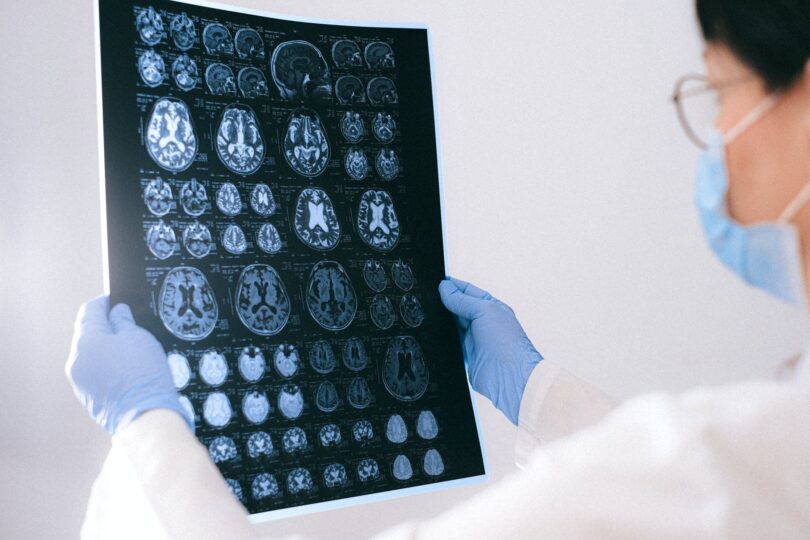Cortexyme (CRTX) presents a causative mechanism for Alzheimer’s Disease (bacterial infection of the brain) that explains amyloid beta 1-42 accumulation, pTau production, and APOE4 genetic risk factors — all hallmarks of disease. CRTX is testing a patent-protected, orally-administered, first-in-class small molecule in a clinical trial to evaluate improvements in actual cognition (ADAS-Cog11) not just biomarkers like amyloid. This is significant because small molecules are cheaper and easier to manufacture than biologics like Biogen’s Aduhelm and cognition is the gold standard for an effective therapy. CRTX is running a phase 2/3 clinical trial with expected readout in Q4 2023.
The science behind the CRTX treatment
Scientists noticed that individuals with gum disease (chronic periodontitis) were at high risk for developing dementia (Ref 1,2). Porphyromonas gingivalis (Pg) is the bacteria that causes gum disease.
Big deal, a bunch of people with oral hygiene problems developed Alzheimer’s Disease, so what? Just give them broad spectrum antibiotics and problem solved. Well, no. Broad spectrum antibiotics have been shown ineffective against Pg.
Pg releases molecules called gingipains (virulence factors) that are essential to Pg survival in a host organism. These molecules make the host environment suitable for the survival of Pg by aiding in nutrient acquisition and disable certain immune defenses. There are several types of gingipains (Ref 3): lysine (Kgp) and arginine (RgpA and RgpB).
Instead of targeting Pg itself, Cortexyme (CRTX) developed a small molecule (COR388) that targets the gingipains essential to Pg survival in human brain and gum tissue (Ref 4).
Mouse Study
Scientists infected the mouths of mice with Pg (oral infection). After 6 weeks, they took brain tissue from the mice and found migrating Pg had infected the brain (Ref 4).
More importantly, amyloid beta 1-42 (AB1-42) production increased significantly after infection (Ref 4). AB1-42 is the hallmark protein aggregate (amyloid plaque) that amyloid theory is based upon — including Biogen’s Aduhelm. Remarkably, Dominy’s and Lynch’s work (co-founders of Cortexyme) shows that AB1-42 has antimicrobial effects that attempt to disrupt the membrane of Pg to kill it. Most work on amyloid theory hasn’t presented a causative reason for the accumulation of AB1-42 in the brain.
Cortexyme presents (1) an ability for oral Pg to infect the brain, (2) how Pg can induce AB1-42 production, (3) a rationale for why the brain would increase production of antimicrobial AB1-42, and (4) *most importantly* that inhibitors of Pg virulence factors can prevent death of the Gad67+ interneurons of the hippocampus (the part of the brain responsible for memory!) after Pg infection (Ref 4).
Cool story bro, but this is one group publishing some outlandish theory. Not quite! Dominy and Lynch were pioneers, but there have since been many peer-reviewed publications from independent groups that validate these findings (Ref 5).
Human Study – Presence in the Alzheimer’s brain
An analysis of post-mortem brain tissue of Alzheimer’s Disease patients shows the presence of gingipains in the hippocampus (region for learning and memory processing) and cerebral cortex gray matter (Ref 4). Further, the DNA of Pg was found in the cerebrospinal fluid of Alzheimer’s Disease patients. Electron microscopy images show that gingipains are even present within neuron cells
Amyloid beta (AB) is a protein well-known as a hallmark of Alzheimer’s Disease. The precursor protein APP can be cut multiple ways to generate various forms of AB. AB1-42 is the hallmark “plaque” forming variety commonly associated with Alzheimer’s Disease. An experiment where Pg was mixed with AB1-42 showed higher levels of Pg death relative to Pg mixed with other forms of AB like AB1-40 (Ref 4). In the brain tissue of Alzheimer’s Disease patients, fluorescent microscopy showed that intracellular amyloid aggregates and gingipains (RgpB) often are found in the same location (Ref 4). This suggests that AB1-42 is being produced by the brain in an effort to kill invading Pg and that the build-up of amyloid plaques is a potential consequence of this anti-microbial response.




